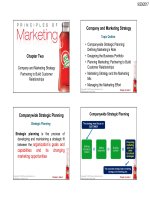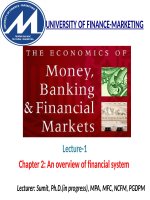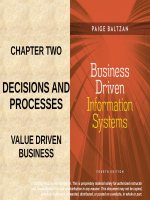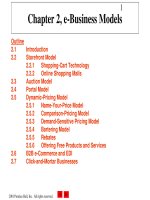Lecture E-Commerce - Chapter 2: E-Commerce
Bạn đang xem bản rút gọn của tài liệu. Xem và tải ngay bản đầy đủ của tài liệu tại đây (793 KB, 39 trang )
CSC 330 E-Commerce
Teacher
Ahmed Mumtaz Mustehsan
GM-IT CIIT Islamabad
Virtual Campus, CIIT
COMSATS Institute of Information Technology
T1-Lecture-2
E Commerce:
Chapter-1
T1-Lecture-2
For Lecture Material/Slides Thanks to: Copyright © 2010 Pearson Education, Inc
Objectives
Classification of computers. Computer network.
Introduction to internet, growth of internet.
Introduction to web and growth of web.
Internet and Web gave birth to e- commerce.
Understand the evolution from internet to e-commerce.
Define e-commerce and describe how it differs from e-business.
Identify and describe the unique features of e-commerce
technology and discuss their business significance.
Describe the major types of e-commerce.
Evolution of e-commerce.
Discuss the origins and growth of e-commerce.
Identify the factors that will define the future of e-commerce.
Describe the major themes underlying the study of e-commerce.
Identify the major academic disciplines contributing to ecommerce.
T1-Lecture-2 CSC330 E Commerce
Ahmed Mumtaz Mustehsan
Copyright © 2010 Pearson Education, Inc
1-3
Computer classifications
Mainframes:
- term for very large computers
- used to handle large amount of data or
complex processes
- main advantage is reliability
Midrange:
- medium sized, less expensive and smaller
- usually a server
Micro-computer:
- work stations with computing capabilities
- single-users systems linked to form a network
T1-Lecture-2 CSC330 E Commerce
Ahmed Mumtaz Mustehsan
Copyright © 2010 Pearson Education, Inc
1-4
What is a network
Series
of points or nodes interconnected by
communication paths
Node is a connection point for transmitting data
Network can interconnect with other networks to
form global networks
T1-Lecture-2 CSC330 E Commerce
Ahmed Mumtaz Mustehsan
Copyright © 2010 Pearson Education, Inc
1-5
Benefits of a network
Facilitates
resource sharing
Provides reliability
Cost effective
Provide a powerful medium across geographical
divide
T1-Lecture-2 CSC330 E Commerce
Ahmed Mumtaz Mustehsan
Copyright © 2010 Pearson Education, Inc
1-6
when internet born
Worldwide
network of computer networks built on
common standards
Created in late 1960s (1969) when terminals were
connected with mainframe computers.
The purpose was to create a net that can function
even if one center is destroyed in a military attack.
◦Network can continue to be functional even if some
nodes are destroyed, as long as information can
pass through other nodes.
Services include the Web, e-mail, file transfers, etc.
T1-Lecture-2 CSC330 E Commerce
Ahmed Mumtaz Mustehsan
Copyright © 2010 Pearson Education, Inc
1-7
In the 1980´s
Personal
computers or terminals were connected to a
server.
The server was a mainframe, or connected to a
mainframe computer.
The mainframe was connected to another mainframe
of the company in another location via dedicated
lines.
Only large companies could afford the expense and
investment in equipment.
T1-Lecture-2 CSC330 E Commerce
Ahmed Mumtaz Mustehsan
Copyright © 2010 Pearson Education, Inc
1-8
Geographical Distance
Local
area network (LAN): small area, share a
single server
Metropolitan area network (MAN): a wider network,
can bridge several LAN’s
Wide area network (WAN): a broader area covered,
can include several MAN’s
T1-Lecture-2 CSC330 E Commerce
Ahmed Mumtaz Mustehsan
Copyright © 2010 Pearson Education, Inc
1-9
Network crossed boundaries
Internet:
a network of networks that covers the entire
globe
Connections across countries and continents made
through dedicated fast lines.
A company may have one local network (LAN) in NY,
which is connected to the Internet through a Regional
network.
Well established in North America, Europe and
certain Asian countries
T1-Lecture-2 CSC330 E Commerce
Ahmed Mumtaz Mustehsan
Copyright © 2010 Pearson Education, Inc
110
When The Web born
Most
popular Internet service
Developed in early 1990s
Provides access to Web pages
◦HTML documents that may include text, graphics,
animations, music, videos
Web content has grown exponentially
◦2 billion Web pages in 2000
◦ At least 40–50 billion pages today (2010)
◦Now ? (Crossed Trillian)
T1-Lecture-2 CSC330 E Commerce
Education, Inc
Ahmed Mumtaz Mustehsan
Copyright © 2010 Pearson
111
The Growth of the Internet, Measured by
Number of Internet Hosts with Domain Names
SOURCE: Internet Systems Consortium,
Inc., 2009.
T1-Lecture-2 CSC330 E Commerce
Ahmed Mumtaz Mustehsan
Copyright © 2010 Pearson Education, Inc
112
web to web 2.0 ; another evolution
e-commerce, internet, set of applications and social
media brought together the evolution of web usually
called web 2.0;
The Applications and Technologies allowed the users to:
Create
and share content, preferences,
bookmarks, and online personas, participate in
virtual lives, build online communities
Examples
◦YouTube, Photobucket, Flickr, Google, iPhone,
MySpace, Facebook, LinkedIn, Second Life,
Wikipedia
T1-Lecture-2 CSC330 E Commerce
Ahmed Mumtaz Mustehsan
Copyright © 2010 Pearson Education, Inc
13
The Internet and
the evolution
of corporate
computing gives
birth to
e-commerce
T1-Lecture-2 CSC330 E Commerce
Ahmed Mumtaz Mustehsan
1Copyright © 2010 Pearson Education, Inc
14
What is E-commerce?
Use
of Internet and Web for business transection.
More
formally:
◦Digitally enabled commercial transactions
between and among organizations and
individuals.
T1-Lecture-2 CSC330 E Commerce
Ahmed Mumtaz Mustehsan
Copyright © 2010 Pearson Education, Inc
115
E-commerce vs. E-business
E-business:
Digital
enablement of transactions and processes
within a firm, involving information systems under
firm’s control.
Does
not include commercial transactions involving
an exchange of value across organizational
boundaries
T1-Lecture-2 CSC330 E Commerce
Ahmed Mumtaz Mustehsan
Copyright © 2010 Pearson Education, Inc
116
The Difference Between E-commerce
and E-Business
T1-Lecture-2 CSC330 E Commerce
Ahmed Mumtaz Mustehsan
Copyright © 2010 Pearson Education, Inc
117
Why Study E-commerce?
E-commerce
technology is different, more powerful
than previous technologies
E-commerce
bringing fundamental changes to
commerce. Introduce new buzz words:
Marketplace: a physical place where you go for
business transection.
Marketspace: marketplace extended beyond traditional
boundaries; removed from temporal and geographic
limitations.
Information asymmetry: any disparity in relevant market
information among parties in a transection.
T1-Lecture-2 CSC330 E Commerce
Ahmed Mumtaz Mustehsan
1Copyright © 2010 Pearson Education, Inc
18
Unique Features of E-commerce Technology
Ubiquity: available everywhere anytime, i.e. Internet/Web
technology is available everywhere; at work, at home, and
elsewhere via mobile devices and round the clock
(anytime).
2. Global reach: the total number of users or customers an ecommerce business can obtain is a measure of its reach.
The technology reaches across cultural and national
boundaries, round the globe.
3. Universal standards: technical standard of conducting ecommerce. There is one set of technology standards,
namely Internet standards as compared to different
standards followed by different nations.
4. Information richness: complexity of the content of a
message. Unlimited information of a product is available
through video, audio, and text messages at internet and
social media.
1.
T1-Lecture-2 CSC330 E Commerce
Ahmed Mumtaz Mustehsan
Copyright © 2010 Pearson Education, Inc
119
Unique Features of E-commerce Technology
Interactivity: The technology works through interaction with
the user. One shopkeeper can handle large number of
clients simultaneously at internet.
6. Information density: the total amount of information
available to all market stakeholders. the technology
reduces information collection costs and raises quality
through social media.
7. Personalization/customization: Personalization: The
targeting of marketing messages to specific individuals by
adjusting the message to a person's name, interests, and
past purchases. (Customization) delivery of product or
service based on a user's preferences or prior behavior
8. Social technology: user content generation and social
networking. The e-commerce technologies have evolved
users to create and generate contents in the form of web,
Facebook pages, text, video, music and photos with
worldwide communities.
5.
T1-Lecture-2 CSC330 E Commerce
Ahmed Mumtaz Mustehsan
1Copyright © 2010 Pearson Education, Inc
20
Types of E-commerce
Classified by Market Relationship
Business-to-Consumer
(B2C)
◦e-commerce online businesses attempt to reach
individual consumers.
Business-to-Business
(B2B)
◦e-commerce online businesses selling to other
businesses
Consumer-to-Consumer
(C2C)
◦e-commerce consumers selling to other consumers
T1-Lecture-2 CSC330 E Commerce
Ahmed Mumtaz Mustehsan
Copyright © 2010 Pearson Education, Inc121
Types of E-commerce
Classified by Technology used
Peer-to-Peer
(P2P)
◦e-commerce use of peer-to-peer technology, which
enables Internet users to share files and computer
resources directly without having to go through a
central Web server, (example sharing videos through
Torrents)
Mobile
commerce (M-commerce)
◦m-commerce use of wireless digital devices to enable
transactions on the Web
T1-Lecture-2 CSC330 E Commerce
Ahmed Mumtaz Mustehsan
Copyright © 2010 Pearson Education, Inc
122
Evolution of E-Commerce
1995–2000:
Innovation
◦Key concepts developed
◦Dot-coms; heavy venture capital investment
2001–2006:
Consolidation
◦Emphasis on business-driven approach
2006–Present:
Reinvention
◦Extension of technologies
◦New models based on user-generated content,
social networking, services
T1-Lecture-2 CSC330 E Commerce
Ahmed Mumtaz Mustehsan
Copyright © 2010 Pearson Education, Inc
123
Origins & Growth of E-commerce
Precursors:
◦Baxter Healthcare
◦Electronic Data Interchange (EDI)
◦French Minitel (1980s videotext system)
◦None had functionality of Internet
1995:
Beginning of e-commerce
◦First sales of banner advertisements
Since
then, e-commerce fastest growing form of
commerce in the United States
T1-Lecture-2 CSC330 E Commerce
Ahmed Mumtaz Mustehsan
Copyright © 2010 Pearson Education, Inc
124
E-COMMERCE TECHNOLOGIES
A commercial History
T1-Lecture-2 CSC330 E Commerce
Ahmed Mumtaz Mustehsan
Copyright © 2010 Pearson Education, Inc
125









